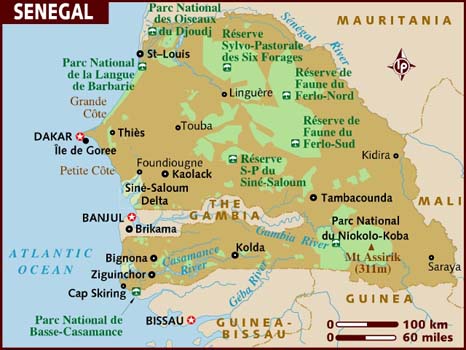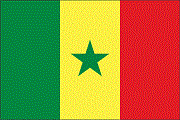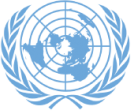
Senegal is located at the westernmost point of Africa in the Atlantic Ocean, surrounded by the Continent of Africa, Europe and America . It is at an intersection of great maritime and aerial routes.
Its area of 196 722 sq km is bordered by Mauritania in the North, Mali in the East, Guinea and Guinea Bissau in the South and by a 550 km coastline of the Atlantic Ocean in the West.
Dakar (550 sq km), its capital, is a peninsula located at the extreme West.
Senegal is a flat land with sandy grounds. It has an altitude lower than 130 meters except in the southeast, near the Guinean border.
Three westbound rivers cross the country: The Senegal River (1700 km) in the North, The Gambia River (750 km) and the Casamance River (300 km) in the South.
Climate and Vegetation
Senegal has a dry tropical climate with two seasons: a dry season from November to June and a raining Season from July to October.
Senegal has three types of vegetation: the Forest in the South, the Savanna in the Center and the Steppe in the North.
Population
Estimated Population (2009 est. ): 12 171 265
Density in 2009: 61.9 inhabitants by sq. km
Female Population (2009 est. ): 6 150 750
Male Population (2009 est. ): 6 020 515
Independence
Senegal accessed independence on 4 April 1960 from France. The first President of Senegal was Leopold Sédar Senghor from 1960 to 1981. His successor, Abdou Diouf, led the country until the March 2000 elections, through which Abdoulaye Wade became the third President of the Republic of Senegal .
Political Organization
The Republic of Senegal is secular, social and a constitutional democracy. It ensures equality before the law of all its citizens, without distinction of origin, race, sex and religion. It respects all belief systems.
French is the Official language of the Republic of Senegal . The National languages are Jola, Mandinka, Pular, Serer, Soninke, Wolof and any other national language to become codified.
A pluralist Presidential Regime
The President of the Republic is elected by majority vote for a five year mandate. The actual president of the Republic, Maître Abdoulaye Wade, was first elected on 19 March 2000 before being reelected for a second term in 2007.
The Parliament
The representative assemblies of the Republic of Senegal are called the National Assembly and the Senate. Their Members are titled deputies to the National Assembly and Senators.
Administrative Organization
There are fourteen regions in Senegal . The Capital of these regions are: Dakar , Diourbel, Fatick, Kaffrine, Kédougou, Kaolack, Kolda, Louga, Matam, Saint Louis , Sedhiou, Tambacounda, Thies, Ziguinchor.
Key Indicators
GDP: 5 944 Billions FCFA (en 2008)
GDP per Capita : 501 978 FCFA (en 2008)
Growth Rate: 3,3% (en 2008)
Human Development Index (HDI)(2005) (UNDP Report) : 0,499
Inflation Rate: 5,8 % (in 2008)
Literacy: 41,8 % ( 2007)
Gross Enrollment Index: 86 % (2007)
Currency
CFA West African CFA franc (XOF) has been pegged to the euro at a rate of 655.957 CFA francs per euro


